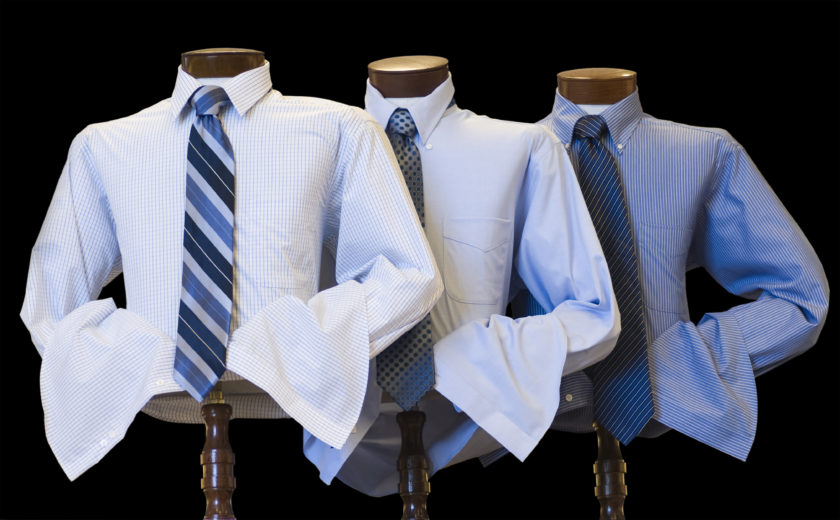The dress shirt, as we know it, is a fundamental part of men’s fashion. And as with any trade mastering the fundamentals is key before adding your own twist and tastes. Today, the soft cotton shirt remains the bread and butter of the well-dressed caballero, yet much too often one fails to conquer this core part of their wardrobe. Here, then, are a few tips for selecting and maintaining this closet staple:
Style
There is no such thing as “one size fits all” when it comes to this style of shirt even though manufacturers make shirts in standard sizes that will fit the average man. Depending on the look and feel you want to convey, pay attention to what cut and fit look best and work with your body type.
If you’re lucky enough to have a fit and trim trunk (no belly or overhang), a tailored or slim-fit shirt should be considered an option since they fit tighter around the chest and sides. If you’re working on reducing your gut or need some extra give throughout the day, a standard-fit or full-cut shirt will hang differently—a bit looser around the chest and sides. If you’re genetically blessed with broad shoulders and barrel chest, an athletic cut shirt which is cut wider on top and fitted at the waist, is your best option.
Fabric
Cotton is king. While Jay Gatsby’s color palette might be a bit much for the conservative-minded gentlemen, you’ll want to stick with cotton shirts for the most part. Flannel is fine for fall or winter and linen will work well in the summer. But if you’re looking for a basic shirt fabric that can be worn year-round, cotton is the way to go.
For something a bit more high-end that wears a bit lighter, try offerings made from Turnbull & Asser’s Sea-Island cotton – a kind of long-staple cotton from Egypt that is grown in the Caribbean as well as some islands off the coast of the South East United States.For something more durable try an oxford shirt, a cotton fabric that features a basket weave.
More on dress shirt patterns and a primer on collars after the jump…
Patterns
Solids: Once upon a time, professionals wore white shirts while manual workers wore colored shirts (presumably because the dirt that stained it wouldn’t be quite so obvious). We still tend to divide the masses into “white collar” criminals and “blue collar” workers, even though there isn’t much of a distinction today. While the classic white shirt still has its place, recently checks and stripes have become fairly standard for the sartorially inclined.
Stripes: Never mind the Beatles and The Rolling Stones, the bold stripes of London’s Jermyn Street brand represent the British Invasion that’s still going strong. If you want to go “authentic,” take a walk over or go online to Turnbull & Asser. If you’re simply looking to capture the spirit of the candy stripe, drop in to Charles Tyrwhitt or Thomas Pink.
Prince of Wales Check: Glen plaid or Glenurquhart check is a woolen fabric with a woven twill design of small and large checks. The name is taken from the valley of Glenurquhart in Iverness-shire, Scotland. This pattern is nicknamed the “Prince of Wales Check,” as it was popularized by the Duke of Windsor when he was the Prince of Wales in the 1920s and 1930s.
Collars
Turn-Down Collar: In its “forward point” or “straight collar” version, you have the standard collar for business — but it’s also appropriate for other occasions. The slings and arrows of outrageous fashion have led, at one time or another, to short and wide or long and slim collars having their moment in the spotlight, but stick with the basics and you’ll always be well-dressed.
English Spread Collar: There are a variety of spread collars, but stick with the medium spread. It works well for business and casual settings. Ralph Lauren, among many other brands, offers a full English spread in the form of its Keaton collar. While it does make a statement, be wary – there is something inherently untrustworthy about a collar made to be worn with a Windsor knot; which is, after all, named for a sartorial icon who rarely strayed very far from the “four in hand” knot. Do with that knowledge what you will . . .
Button-Down Collar: Here, the collar points are held down by a button on the shirt. In keeping with its supposed origins, this shirt remains a casual staple. While it has been said that the button-down collar originated with British polo players who wanted to keep their collars “down” while riding, it seems more likely that the button-down was created by Brooks Brothers in response to an Ivy League fad of the 1920s.

